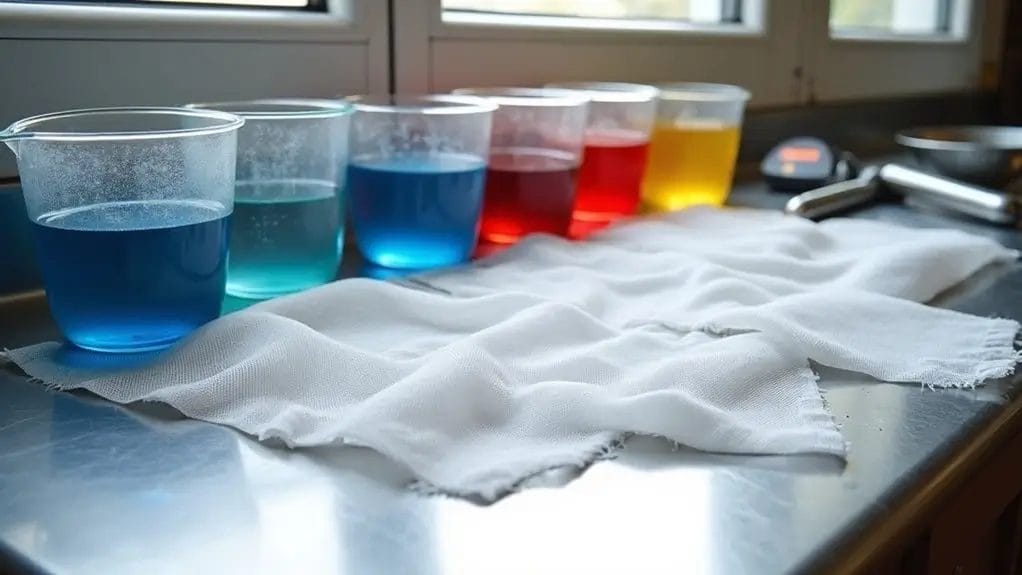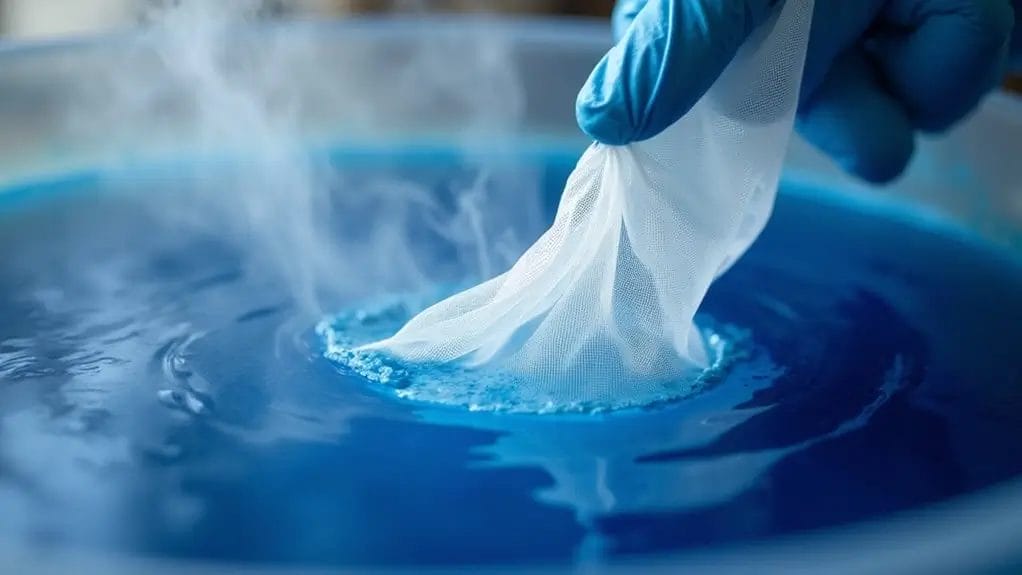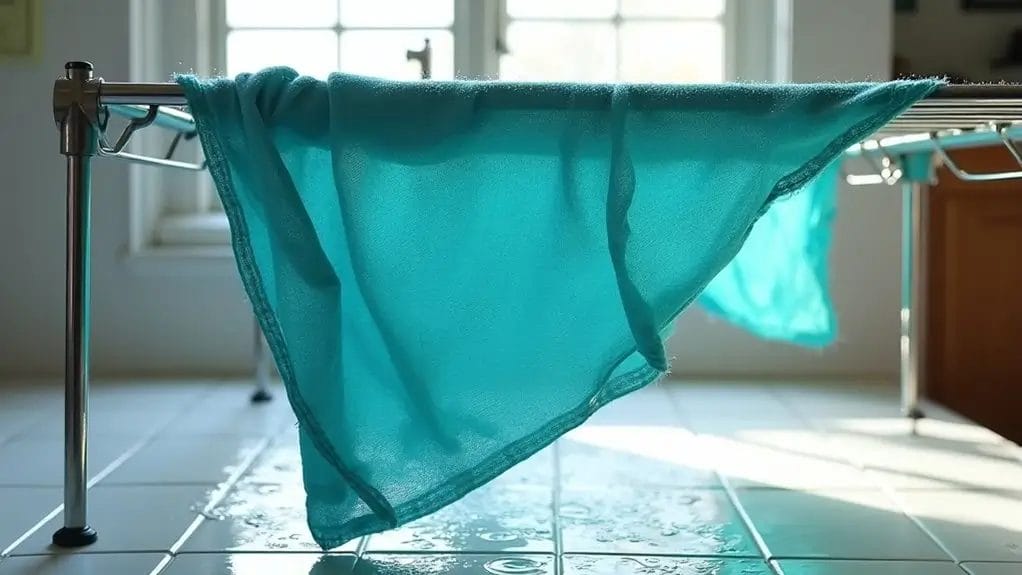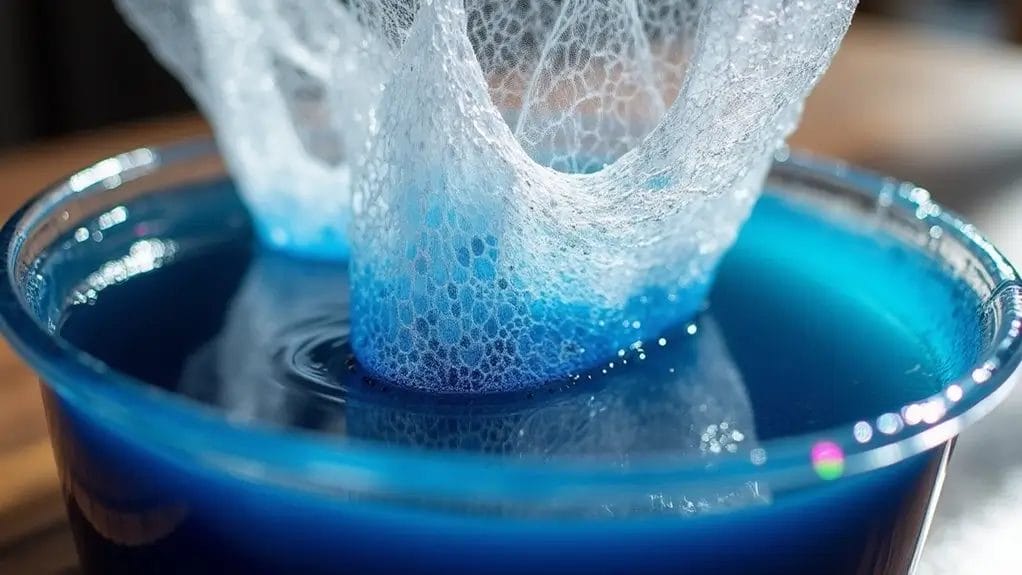You'll find that transforming plain mesh fabric into a vibrant masterpiece isn't as challenging as it might seem. Whether you're crafting costumes, updating home décor, or breathing new life into athletic wear, the right dyeing technique can turn ordinary mesh into something extraordinary. With basic supplies from your local craft store and a careful approach to temperature and timing, you'll discover a world of creative possibilities waiting to unfold.
Key Takeaways
- Pre-wash mesh fabric in warm soapy water and keep it damp to ensure better dye absorption.
- Heat water to 180°F (82°C) in a stainless steel pot before adding synthetic fabric dye.
- Submerge mesh fabric in the heated dye solution for 30 minutes, maintaining consistent temperature throughout the process.
- Rinse dyed fabric under warm water until clear, then wash with soap to remove residue.
- Air dry away from direct sunlight and heat-set the dye through a warm wash cycle.
Preparing to Dye Mesh Fabric

Before you begin dyeing mesh fabric, you'll need to gather your materials including synthetic fabric dye, a large steel pot, metal tongs, dish soap, and protective gloves.
Pre-wash your mesh fabric in warm, soapy water to remove any protective coatings or residues, keeping the fabric damp to facilitate better dye absorption.
Set up your workspace by covering surfaces with protective materials, guaranteeing proper ventilation, and preparing your pot of water at approximately 180°F (82°C).
Gathering Necessary Materials
Successful mesh fabric dyeing starts with assembling the right tools and materials.
You'll need synthetic-specific fabric dye or similar products designed for mesh fabric. Gather a large stainless steel pot, metal tongs, and a stirring implement that won't stain.
Don't forget protective gloves, dish soap to help the dye adhere, and a well-ventilated workspace.
If you're dyeing the mesh coverup black or any other color, you'll also need measuring cups, a thermometer to monitor water temperature, and plenty of newspaper or drop cloths to protect your work surface from potential spills.
Pre-Washing Your Mesh Fabric
To guarantee proper dye absorption, you'll need to thoroughly pre-wash your mesh fabric to remove any manufacturing residues, oils, or coatings.
Fill your sink with warm soapy water and gently submerge your synthetic materials, working the water through the mesh with your fingers. Avoid harsh scrubbing that could damage the delicate fibers.
Rinse the fabric thoroughly until the water runs completely clear, ensuring no soap remains.
Keep the mesh fabric damp after rinsing, as this promotes better dye adherence. Don't wring or twist the material; instead, press it gently between clean towels to remove excess water.
Setting Up Your Dyeing Workspace
Creating a proper dyeing workspace requires three essential elements: adequate ventilation, protected surfaces, and organized supplies.
Set up near an open window or ventilated area to minimize fumes during the dyeing process. Cover your work surface with plastic sheeting and lay out newspapers for additional protection from the dye solution.
Arrange your materials in order of use: mesh fabric (pre-washed and damp for better dye adherence), fabric dye, measuring tools, and safety equipment like rubber gloves and protective eyewear.
Keep a clean towel nearby for spills, and guarantee all metal utensils are within easy reach. Position your heat source away from flammable materials.
Methods to Dye Mesh Fabric

You'll find three effective methods for coloring mesh fabric: traditional fabric dye, fabric paint, and fabric spray.
For the fabric dye method, you'll need to maintain your solution at 180°F (82°C) while constantly stirring the mesh for 30 minutes.
Whereas fabric paint requires careful brushwork in one direction with synthetic brushes, and fabric spray needs consistent 6-8 inch distance coverage.
Each method demands specific preparation and handling techniques, with fabric dye requiring pre-dampened material, paint needing a flat working surface, and spray requiring proper ventilation and masking.
Using Fabric Dye
When dyeing mesh fabric, selecting the right synthetic fabric dye is essential for achieving lasting color. You'll need dyes specifically made for nylon fabrics, as regular fabric dye won't adhere properly to synthetic mesh.
Start by heating water to 180°F in a steel pot. Mix your dye with water and add dish soap to help with adhesion.
Submerge your pre-dampened mesh fabric and stir continuously for 30 minutes, maintaining the temperature. Use metal tongs to remove the fabric, then rinse until the water runs clear. The dyeing process requires careful attention to temperature and timing for even color distribution.
Applying Fabric Paint
An alternative to traditional dyeing methods, fabric paint offers precise control when coloring mesh fabric.
Begin by laying your textile flat on a protected surface and securing edges with masking tape. If you're using fabric spray, hold the can 6-8 inches away and apply in overlapping rows. For brush-on paint, use synthetic bristles and work in one direction only.
Allow each layer to dry completely before adding new colors. When layering colors, protect previously painted areas with tape. You'll need 15-30 minutes between applications.
Remember to work in a well-ventilated area and pat off excess paint to prevent clumping.
Utilizing Fabric Spray
Fabric spray delivers consistent, even coverage when dyeing mesh materials, making it an ideal choice for larger projects.
Hold your fabric spray paint 6-8 inches away from the mesh, applying in smooth, overlapping strokes. You'll want to work in a well-ventilated area and protect surrounding surfaces.
After the initial application dries for 30 minutes, check for any missed spots. Once you're satisfied with the coverage, let it cure completely.
Follow post-dyeing care instructions by washing the fabric separately in your washing machine with mild detergent. Remember to run an empty cycle afterward to remove any residual dye.
Always wear protective gear during mesh dyeing techniques.
Post-Dyeing Care and Techniques

After dyeing your mesh fabric, you'll need to rinse it thoroughly under warm running water until the water runs completely clear, squeezing gently but avoiding wringing or twisting.
To set the dye permanently, wash the fabric in warm, soapy water, then air dry it away from direct sunlight to prevent fading and maintain the fabric's integrity.
Once your mesh fabric is fully dry, you can enhance its appearance with decorative embroidery, using a stabilizer beneath the mesh to prevent puckering and guarantee smooth stitching.
Rinsing and Drying Your Fabric
Once you've completed the dyeing process, you'll need to rinse your mesh fabric thoroughly under warm running water until the water runs completely clear.
After rinsing, wash the fabric in warm soapy water to remove any remaining fabric dye residue.
Gently squeeze the fabric without wringing or twisting to prevent damage to the delicate mesh structure.
To dry your newly dyed mesh fabric, hang it indoors away from direct sunlight to prevent fading.
Avoid using a dryer, as high heat can affect the dye's colorfastness.
Let the fabric air dry completely before handling or wearing it.
Setting the Dye
To guarantee your newly dyed mesh fabric maintains its vibrant color, you'll need to properly set the dye through a heat-setting process.
After completing the dyeing process with synthetic fabric dye, wash your mesh in warm, soapy water to remove excess color. For achieving the perfect shade retention, run the fabric through your washing machine on a warm cycle, followed by an empty cycle to clear residual dye.
Following proper post-dyeing care, dry your mesh away from direct sunlight.
Remember safety precautions: wear gloves during handling and wash the dyed fabric separately from other items for the first few washes.
Embroidery Techniques on Dyed Mesh
Embroidering on dyed mesh fabric requires special handling and precise techniques to maintain both the fabric's integrity and your design's quality.
After your fabric dyeing process is complete, select an embroidery hoop that's slightly larger than your intended design area.
When working with illusion tulle or sports mesh, you'll need to use a water-soluble stabilizer underneath to prevent thread pull-through. Choose lightweight threads that won't overwhelm the delicate mesh fashion aesthetic.
Start from the center of your design and work outward, keeping tension consistent.
You'll create a unique fashion statement by combining your dyed foundation with carefully placed embroidered elements.
Creative Ideas for Dyed Mesh Fabric

Your dyed mesh fabric opens up endless creative possibilities, from crafting ethereal dance costumes to designing unique home décor pieces.
You'll find that layering different colored mesh creates striking visual effects, especially when incorporating gradient dyes or ombré patterns into fashion accessories like scarves and shawls.
Try experimenting with tie-dye techniques or strategic color blocking to transform your mesh fabric into eye-catching window treatments, room dividers, or even artistic wall hangings.
Incorporating Textiles into Fashion
Three striking applications make dyed mesh fabric a versatile addition to any fashion collection.
When you've mastered the diy dyeing process, you'll discover endless possibilities for incorporating your custom-dyed mesh into wearable pieces.
- Layer a vibrant mesh coverup over solid garments, achieving the perfect shade to complement your existing wardrobe.
- Create intricate fashion hacks by combining differently dyed mesh panels for avant-garde statement pieces.
- Design sheer overlays with fabric dye gradients, embracing the custom designer life while adding depth to simple silhouettes.
The transparent nature of mesh allows you to experiment with color blocking and dimensional effects that transform basic outfits into sophisticated ensembles.
Craft Projects Using Dyed Mesh
Once you've mastered the art of dyeing mesh fabric, countless creative projects await your artistic touch.
Transform plain tulle into vibrant mesh dress covers for special occasions, or create trendy beach coverups that are currently trending on fashion TikTok tutorials.
After learning how to dye mesh effectively, you'll discover that repeating the dye process with different patterns yields unique results.
Try crafting gradient-dyed scarves, colorful room dividers, or decorative overlays for existing garments.
Using fabric dye techniques, you can even design cute coverup ideas for swimwear or update old dance costumes with fresh, eye-catching hues.
Tips for Experimenting with Colors and Patterns
While traditional solid-color dyeing produces beautiful results, experimenting with creative patterns can transform mesh fabric into striking works of art.
- Create ombré effects by gradually dipping sections of mesh into the dye bath, holding each level for different durations to achieve the perfectshade.
- Use rubber bands for tie-dye patterns, bunching fabric tightly for different results.
- Apply resist techniques with painter's tape or wax, perfect for followers who want geometric designs.
Remember to heat-set your patterns properly to guarantee lasting vibrancy.
Frequently Asked Questions
Can Mesh Fabric Be Dyed in Cold Water?
No, you can't effectively dye mesh fabric in cold water. You'll need hot water at around 180°F (82°C) for synthetic dyes to properly bond with your mesh's synthetic fibers. Cold water won't achieve desired results.
How Long Does the Dye Color Typically Last on Mesh Fabric?
When you've properly dyed mesh fabric using synthetic dyes and hot water, your color should last 6-12 months with regular wear. You'll notice better longevity if you wash in cold water and avoid direct sunlight.
Will Dyeing Affect the Stretchability of Mesh Fabric?
If you've followed proper dyeing temperatures and techniques, your mesh fabric's stretchability won't be markedly affected. However, if you overheat the fabric or use harsh chemicals, you'll risk compromising its elastic properties.
Can I Mix Different Synthetic Dye Brands Together?
You shouldn't mix different synthetic dye brands together, as they may contain incompatible chemicals that could react poorly, creating uneven colors or damaging your fabric. Stick to one brand for consistent, reliable results.
Does the Mesh Hole Size Affect How Well the Fabric Takes Dye?
Yes, your mesh's hole size affects dye absorption. Larger holes allow better dye penetration and circulation, while tighter mesh patterns may need longer soaking time to achieve even color coverage throughout the fabric.
Conclusion
You've now mastered the art of dyeing mesh fabric through careful preparation, precise temperature control, and patient attention to detail. Your newly dyed mesh opens up endless creative possibilities, from theatrical costumes to home décor. Remember to maintain your dyed mesh's vibrancy by washing it separately in cold water and storing it away from direct sunlight. With these techniques, you'll transform ordinary mesh into stunning, personalized pieces.


0 comments